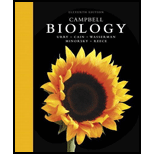
Concept explainers
Explain why human offifuing resemble their parents but are not identical to them.
To explain: Why human offspring are similar to their parents but they are not identical to them.
Introduction: Heredity is the process of the transmission of traits or heritable information to the next generation in the form of DNA. Humans reproduce sexually. During sexual reproduction, the genetic information from both the parents gives a unique gene combination in the offspring. The offspring resemble their parents but are somewhat different in their genetic makeup, which explains the genetic variation.
Explanation of Solution
Humans undergo sexual reproduction and inherit one chromosome of each homologous pair of chromosomes from each parent. Each somatic cell in humans consists of 46 chromosomes, which are two sets of 23 chromosomes each (maternal and paternal set).
During sexual reproduction, most of the variation arises during fertilization and meiosis. During meiosis, the homologous chromosomes randomly align with their homologs at metaphase I. According to the law of independent assortment of chromosomes, each daughter cell shows either maternal or paternal chromosome combinations. Thus, there is a 50% chance that the offspring gets maternal or paternal chromosomes or a combination of both. Secondly, crossing over forms the recombinant chromosomes that consist of a unique combination of genes in the offspring. The next aspect is random fertilization, which could be between any male gamete and female gamete. These factors relate to the fact that the offspring resemble their parents but are not exactly identical.
Want to see more full solutions like this?
Chapter 13 Solutions
Campbell Biology (11th Edition)
Additional Science Textbook Solutions
College Physics: A Strategic Approach (3rd Edition)
Physical Science
Introductory Chemistry (6th Edition)
Chemistry: Atoms First
Genetics: From Genes to Genomes
- What is behavioral adaptarrow_forward22. Which of the following mutant proteins is expected to have a dominant negative effect when over- expressed in normal cells? a. mutant PI3-kinase that lacks the SH2 domain but retains the kinase function b. mutant Grb2 protein that cannot bind to RTK c. mutant RTK that lacks the extracellular domain d. mutant PDK that has the PH domain but lost the kinase function e. all of the abovearrow_forwardWhat is the label ?arrow_forward
- Can you described the image? Can you explain the question as well their answer and how to get to an answer to an problem like this?arrow_forwardglg 112 mid unit assignment Identifying melting processesarrow_forwardGive only the mode of inheritance consistent with all three pedigrees and only two reasons that support this, nothing more, (it shouldn't take too long)arrow_forward
- Oarrow_forwardDescribe the principle of homeostasis.arrow_forwardExplain how the hormones of the glands listed below travel around the body to target organs and tissues : Pituitary gland Hypothalamus Thyroid Parathyroid Adrenal Pineal Pancreas(islets of langerhans) Gonads (testes and ovaries) Placentaarrow_forward
 Human Heredity: Principles and Issues (MindTap Co...BiologyISBN:9781305251052Author:Michael CummingsPublisher:Cengage Learning
Human Heredity: Principles and Issues (MindTap Co...BiologyISBN:9781305251052Author:Michael CummingsPublisher:Cengage Learning Biology Today and Tomorrow without Physiology (Mi...BiologyISBN:9781305117396Author:Cecie Starr, Christine Evers, Lisa StarrPublisher:Cengage Learning
Biology Today and Tomorrow without Physiology (Mi...BiologyISBN:9781305117396Author:Cecie Starr, Christine Evers, Lisa StarrPublisher:Cengage Learning Biology 2eBiologyISBN:9781947172517Author:Matthew Douglas, Jung Choi, Mary Ann ClarkPublisher:OpenStax
Biology 2eBiologyISBN:9781947172517Author:Matthew Douglas, Jung Choi, Mary Ann ClarkPublisher:OpenStax Principles Of Radiographic Imaging: An Art And A ...Health & NutritionISBN:9781337711067Author:Richard R. Carlton, Arlene M. Adler, Vesna BalacPublisher:Cengage Learning
Principles Of Radiographic Imaging: An Art And A ...Health & NutritionISBN:9781337711067Author:Richard R. Carlton, Arlene M. Adler, Vesna BalacPublisher:Cengage Learning Biology: The Dynamic Science (MindTap Course List)BiologyISBN:9781305389892Author:Peter J. Russell, Paul E. Hertz, Beverly McMillanPublisher:Cengage Learning
Biology: The Dynamic Science (MindTap Course List)BiologyISBN:9781305389892Author:Peter J. Russell, Paul E. Hertz, Beverly McMillanPublisher:Cengage Learning





